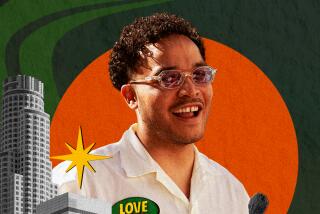‘You got pedigree’: Sgt. Charles J. Shaw II gets a posthumous show at the Bowers Museum
Brenda Matthews likes to be organized. She says it unclutters her mind. Her assortment of color-coded binders in her home and knack for archiving her father Sgt. Charles J. Shaw II’s documents proved to be useful to the public too.
“If you look at my house, you see everything is in a binder. You can trace my life all the way in a binder ... it’s just a habit of mind or a hobby — whatever you want to call it,” Matthews said.
In the fall, the 71-year-old approached the Bowers Museum to see if it was interested in showing Shaw’s paraphernalia that told his life story in the military and in Santa Ana’s Little Texas.
“I walked in and asked them if they would mind housing it for us for whatever time frame ... I wanted to highlight my dad and the history from our perspective,” Matthews said.
In 1943, Shaw enlisted as a Marine and served as a drill instructor for the nation’s only base for Black Marines in Montford Point, N.C. He was transferred to Parris Island, S.C., where he became the first Black instructor to train an integrated platoon. Then in 1953, he was transferred to Camp Pendleton, where he worked in the commissary.
After Shaw died in 1979, Matthews kept some of his belongings, mostly his military documents. She tried to get her dad awarded the Congressional Gold Medal for years, and the ceremony finally happened on Oct. 10 in at the Friendship Baptist Church in Yorba Linda.
A month later, the “Test of Medal: Charles J. Shaw and the Montford Point Marines” exhibit opened at Bowers on Veterans Day. Although the museum couldn’t have a big event for the opening, Shaw’s family members had a chance to see the display.
“Charles Shaw was a pioneer and this exhibit really becomes a 1958 Santa Ana story ... He was one of these important guiding members of Santa Ana. It’s something so near and dear to the city and, of course, it’s got this larger national importance as well,” said Bowers’ assistant curator of collections Mark Bustamante.
The show, located in the floor gallery of the museum, consists of photos, a video and Shaw’s personal possessions including Marine patches and medals with the Congressional Gold Medal as the centerpiece. Putting the exhibit together involved interviews with the Montford Point Marine Assn. and Matthews ,as well as her siblings and uncle.
“I had known a few things about Black culture in Santa Ana. But really in speaking to Brenda for the first time, I learned so much about this community that you never hear about,” Bustamante said.
The other significant part of Shaw’s life was the Bar-B-Que Pit. After Shaw was transferred to Camp Pendleton, his family moved to Santa Ana, where he and his friend, Jim Jones, opened the restaurant, one of the first Black-owned businesses in the city.
Matthews, whose parents are from Elgin, Texas, said the Bar-B-Que Pit was among the only three Texas-style barbecue joints at the time. Black-owned businesses were located around Bristol Street. In the 1960s, most O.C. Black residents didn’t live outside of what was known as Little Texas in Santa Ana. Real estate agents and police officers enforced segregation, and by necessity the city and businesses like the Bar-B-Que Pit became important cultural hubs.
“It just became the spot to go to in Orange County, especially if you’re Black,” Matthews said. “We had military people and celebrities coming in from L.A. and around the area.”
Celebrities such as Redd Foxx stopped by to eat their signature dishes — sweet potato pie, potato salad and homemade sausage. Matthews’ siblings also recall community leaders and town politicians stopping by to ask their dad about his opinion on city matters.
Matthews jokes that her parents broke labor laws with her five siblings. When she was in high school, her job every week was to roll out 500 pie crusts by hand and prep about 200 pounds of potatoes for the homemade potato salad.
Family members operated the Bar-B-Que Pit, which was at 305 N. Hesperian St., until Shaw’s death. Although the family kept ownership through 2018, Fred Burrell took over the day-to-day restaurant operation. Now, the Bar-B-Que Pit location is a rental property.
The exhibit was set to be on view until Jan. 10, but the museum closed, adhering to stay-at-home restrictions in the county during the pandemic. The seven-minute video, with Matthews narrating her father’s life story, is available online along with blog posts that tell the perspectives of Shaw’s children.
On Jan. 2 and 3, the museum will show a recorded presentation by L.E. Johnson, U.S. Marine Corps retiree and Montford Point Marine Assn. vice president, focusing on Shaw’s life and social change within the Marine Corps. On Jan. 10 and 11, former director of the Heritage Museum Kevin Cabrera is slated to speak about Little Texas in a virtual format lecture.
“The good news with my daughters is that they discovered that they have their grandpa on the other side who won a gold medal in the Olympics and then their grandfather on this side of the family who won the Congressional Gold Medal,” Matthews said. “They finally get what I’m trying to tell them — you can do anything. You got pedigree. That’s empowering and they take that to heart.”
If you watch
Legacy of the Montford Point Marines with Mr. L.E. Johnson
When: Jan. 2 and Jan. 3 (recorded presentation is viewable for 24 hours)
Where: online
Cost: general $10, member $5
Info: bowers.org
Little Texas: The Soul of Santa Ana with Kevin Cabrera
When: Jan. 10 and Jan. 11 (recorded presentation is viewable for 24 hours)
Where: online
Cost: general $10, member $5
Info: bowers.org
Castaneda writes for Times Community News.
More to Read
Sign up for Essential California
The most important California stories and recommendations in your inbox every morning.
You may occasionally receive promotional content from the Los Angeles Times.











